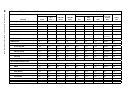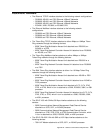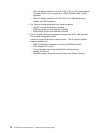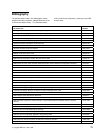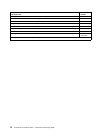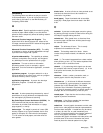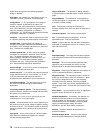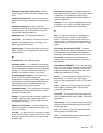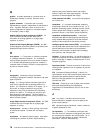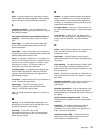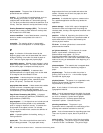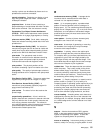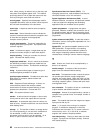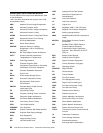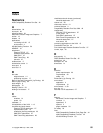G
graphic. A symbol produced by a process such as
handwriting, drawing, or printing. See also
vector
graphics
.
graphic character. A character that is normally
represented by a graphic, independent of code points or
fonts. A graphic character is often in the form of a
spatial arrangement of adjacent or connected strokes;
for example, a letter or digit.
Graphic Object Content Architecture (GOCA). An
IPDS command set that provides data control
information for printing graphics on a page, page
segment, or overlay.
Graphical Data Display Manager (GDDM). An IBM
licensed program that allows pictures to be defined and
displayed through function routines.
H
host system. (1) The primary or controlling computer
in a multiple-computer installation. (2) A computer
used to prepare programs for use on another computer
or on another data-processing system; for example, a
computer used to compile, link edit, or test programs to
be used on another system.
I
ideographic. Pertaining to 2-byte characters
consisting of pictograms, symbolic characters, and other
types of symbols.
image. (1) A string of picture elements organized in
scan lines to represent the contrasting portions of a
picture. (2) A likeness or imitation of an object. (3) In
this printer, an image comprises a string of pels
organized in scan lines to represent the contrasting
portions of a picture. The image may consist of any
data stored as a raster pattern. The term image is
interchangeable with impression and is printed on one
side of a sheet of paper.
Image Object Content Architecture (IOCA). An IPDS
command set to print image data on a page, page
segment, or overlay.
impact printer. A printer in which printing is the result
of mechanical impacts. Contrast with
non-impact
printer
.
impression. An implied or physical page. Used when
calculating the reduction of printer output caused by
switching the printer between duplex and simplex
modes or upper and lower paper supplies. The term
impression is interchangeable with image.
initial machine load (IML). A procedure that prepares
the 3130 for use.
installation. (1) In system development, preparing
and placing a functional unit in position for use. (2) A
particular computing system, including the work it does
and the people who manage it, operate it, apply it to
problems, service it, and use the results it produces.
installation verification procedure. A procedure
distributed with IBM licensed programs that tests the
newly installed IBM programs to verify that the basic
facilities of the programs are functioning correctly.
intelligent printer data stream (IPDS). An architected
host-to-printer
data stream that contains both data and
controls defining how the data is to be presented.
Generally, this information contains basic formatting,
error recovery, and character data.
interface. A shared boundary. An interface might be a
hardware component to link two devices or it might be a
portion of storage or registers accessed by two or more
computer programs.
interlocked mode. Prevents a machine or device from
initiating further operations until an operation in process
is completed.
IPX. Internetwork Packet eXchange. A Novell, Inc.
implementation of the XNS communication protocol that
transports data packets between network devices.
Delivery of the data packets is not guaranteed.
Contrast with
SPX
.
ISO sizes. Pertaining to a set of paper sizes selected
from those standardized by the International
Organization for Standardization (ISO) for use in data
processing.
J
jam. In a printer, a condition where forms have
become blocked or wedged in the forms path so the
printer cannot operate.
JIS. Japanese Industry Standards. Used in reference
to paper standards for size.
job separation. (1) The hardware mechanism that
uses the mark form sequence to distinguish jobs, which
are consecutively stacked in the output stacker. (2) In
the 3130, job offset stacking is used to indicate job
termination. See also
offset stacking
.
78 3130 Advanced Function Printer: Introduction and Planning Guide



